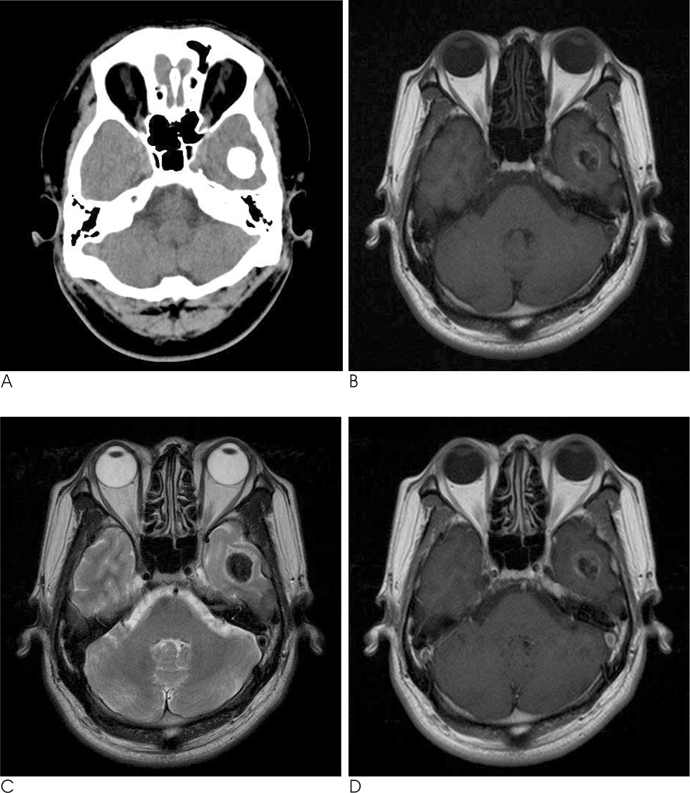J Korean Soc Radiol.
2011 Mar;64(3):217-220. 10.3348/jksr.2011.64.3.217.
Intracranial Gossypiboma Mimicking a Recurrent Low Grade Astrocytoma: Case Report
- Affiliations
-
- 1Department of Radiology, Dongguk University Il-San Hospital, Goyang, Korea. koojb@paran.com
- KMID: 2097940
- DOI: http://doi.org/10.3348/jksr.2011.64.3.217
Abstract
- Gossypiboma is an inflammatory pseudomass formed by a retained surgical sponge or gauze with reactive tissue after surgery. Gossypiboma has been reported most frequently after abdominal or thoracic surgery. As such, gossypiboma following brain surgery is very rare. We report a case of gossypiboma mimicking tumor recurrence in the brain after a craniotomy and surgical excision of a low grade astrocytoma.
MeSH Terms
Figure
Reference
-
1. Rajput A, Loud PA, Gibbs JF, Kraybill WG. Diagnostic challenges in patients with tumors: case 1. Gossypiboma(foreign body) manifesting 30 years after laparotomy. J Clin Oncol. 2003; 21:3700–3701.2. Erdem G, Ates O, Koçak A, Alkan A. Lumbar gossypiboma Diagn. Diagn Interv Radiol. 2010; 16:10–12.3. Jang SW, Kim SJ, Kim SM, Lee JH, Choi CG, Lee DH, et al. MR spectroscopy and perfusion MR imaging findings of intracranial foreign body granuloma: a case report. Korean J Radiol. 2010; 11:359–363.4. Kim AK, Lee EB, Bagley LJ, Loevner LA. Retained surgical sponges after craniotomies: imaging appearances and complications. AJNR Am J Neuroradiol. 2009; 30:1270–1272.5. Martins MCB, Amaral RPG, Andrade CS, Lucato LT, Leite CC. Magnetic resonance imaging findings of intracranial gossypiboma: a case report and literature review. Radiol Bras. 2009; 42:407–409.6. Kopka L, Fischer U, Gross AJ, Funke M, Oestmann JW, Grabbe E. CT of retained surgical sponges (textilomas): pitfalls in detection and evaluation. J Comput Assist Tomogr. 1996; 20:919–923.7. Choi BI, Kim SH, Yu ES, Chung HS, Han MC, Kim CW. Retained surgical sponge: diagnosis with CT and sonography. AJR Am J Roentgenol. 1988; 150:1047–1050.8. Djindjian M, Brugieres P, Razavi-Encha F, Allegret C, Poirier J. Post-operative intracranial foreign body granuloma: a case report. Neuroradiology. 1987; 29:497–499.9. Chater-Cure G, Fonnegra-Caballero A, Baldión-Elorza AM, Jiménez-Hakim . Gossypiboma in neurosurgery. Case report and literature review. Neurocirugia (Astur). 2009; 20:44–48.
- Full Text Links
- Actions
-
Cited
- CITED
-
- Close
- Share
- Similar articles
-
- Intracranial Metastases of Cervical Intramedullary Low-Grade Astrocytoma without Malignant Transformation in Adult
- Intracranial Undifferentiated Sarcoma Arising from a Low-Grade Glioma: A Case Report and Literature Review
- Gossypiboma Mimicking a Soft Tissue Tumor
- Surgical Experience of Multiple Recurrent Astrocytoma: Case Report
- A Case of Astrocytoma in the Corpus Callosum




